For several weeks, the distinctive mural in the corridor at 21 Abovyan Street has captivated passersby. Poet Shushanik Kurghinyan, a prominent figure in Armenian proletarian poetry and one of the first revolutionary poets in Armenia, gazes upon pedestrians with a stern and noble expression.
“Having the accounts of my sex settled with yours,
I also want to fight against the ruthless life -
Bravely like you, holding hands with you,
Standing face-to-face against the being or not being”.
This segment of Shushanik Kurghinyan's poem “I Want to Live” completes the mural, crafted by the award-winning American artist, writer, and activist Molly Crabapple. She arrived in Armenia at the end of May to participate in the third EVN Media Festival in a framework of which this mural was created.
 The mural of Shushanik Kurghinyan at 21 Abovyan Street
The mural of Shushanik Kurghinyan at 21 Abovyan StreetPhoto: Mediamax
After learning the story behind Shushanik Kurghinyan's portrait, Mediamax talked to Molly Crabapple about global revolutions, their successes and failures, the role of art within them, and her romantic love for protests.
- Molly, how do you feel in Armenia? How was the media festival?
- This is my first time in Yerevan, I love it so much. It is an amazing city. Unfortunately, I did not have the opportunity to visit other cities.
The media festival was great. I was deeply honored when John Lee Anderson, one of the greatest war journalists, interviewed me about my work. That was crazy as I should be the one interviewing him about his work.
- How did the idea to draw Shushanik Kurghinyan’s portrait come about? Was that your choice?
- I was willing to draw a woman writer with feminist views. One of the organizers of the festival sent me Shushanik’s poem “I want to live”. For me it was amazing, so we decided I should draw her portrait.

Photo: Mediamax
As you know, she hails from Gyumri, a city much more conservative than Yerevan. Despite this, she was a feminist and socialist in many respects. Therefore, I portrayed her holding a pen, with its ink blending into an image of Gyumri. The idea is that, on the one hand, the words from her pen are part of that that context, but on the other hand, they are also in opposition to it.
- While reading the profile feature about you in Document Journal, I was very interested in the fact that you took an active part in the “Occupy Wall Street” movement against economic inequality, launched in New York in 2011, being involved both as an activist and as an artist. How did you come to that decision?
- I come from a political family. My father is Puerto Rican that is a colony of the US, and he is a socialist. Despite this, when I was growing up, I was much more attracted to drawing nightclubs and pretty girls and stuff like that. When “Occupy” happened, it felt like history was unfolding right outside my window, and I felt both obligated and honored to be part of it.

Photo: Mediamax
If I were a carpenter, I would have been part of it by building things. If I were a cook, I would have been part of it by working in the kitchen. I am an artist, so I drew.
- From your “Drawing blood” memoir, I singled out the following idea: “I realized that art and action could infuse each other. A painting didn’t have to hang in a gallery dead as a pinned butterfly. It could exist in places where people cared as a mural, a stage set, a protest placard. Art could be gorgeous, engaged, and political, working defiant magic on the world.” Based on your own experience, what do you think about how art can influence objective reality?
- I do not know about other countries, but in the United States one of the problems with the world of art is that it has isolated itself so much. It has cut itself off from people while putting itself in little white boxes of the galleries that are for the rich. I hate that as I think that art is for everyone.
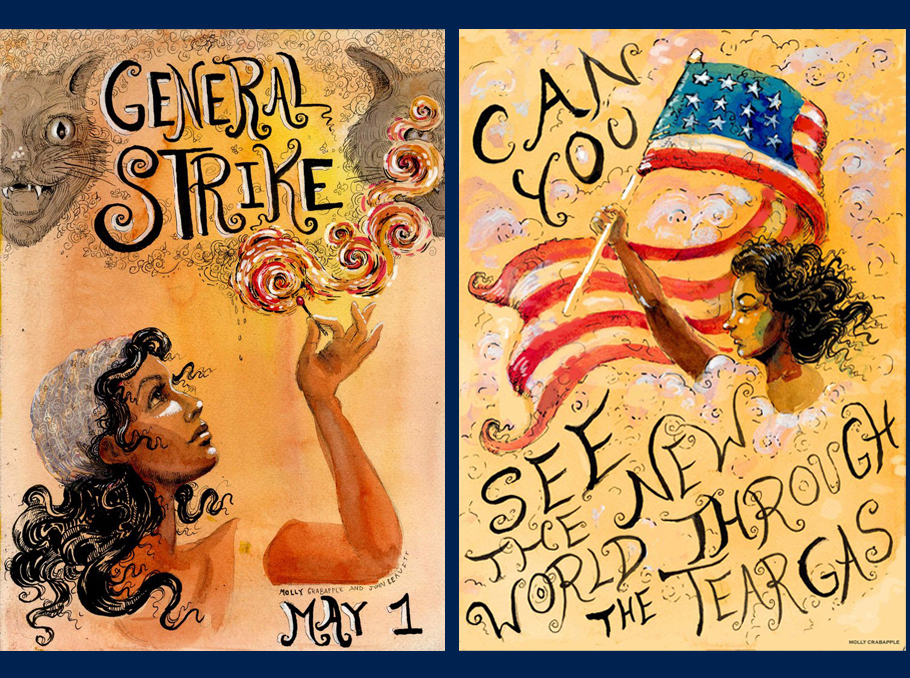 Fine Art by Molly Crabapple on the theme of the “Occupy Wall Street” movement
Fine Art by Molly Crabapple on the theme of the “Occupy Wall Street” movementArt can be on protest signs, it can be in murals, it can be on the streets, it can be in a love letters, etc. It can be everywhere and that was what I wanted for my art. I did not want it to be just something that was pinned like a dead butterfly on a wall. And so I started using my sketchbook first to document “Occupy Wall Street” and when I got to know the organizers, I started making posters for them and also making fine art about them as well.

Photo: Mediamax
Art is a part of the movement, not the whole movement. But art can inspire, seduce, and convince, so it can bring people to protests and drive the actions that ultimately force the change.
- During 2011, in addition to participating in the New York protests, you witnessed acts of disobedience in several different countries. In 2012, you held your exhibition “The Shell Game”, a series of paintings about the revolution and crisis of 2011. At the exhibition's opening, you remarked that it seemed everything could finally change, and that “a new world itself might be at the end of a street demonstration”. Now, more than 10 years have passed, yet when we look at what is happening in the world, everything appears even scarier.
- Yeah… it was dumb of me to think so. Anyone looking at the state of the world now can see how deeply we have failed. The “Arab Spring” protests dissolved into bloody civil wars and hideous dictatorships. Financial inequality is even more entrenched in America. We are currently supporting a genocide in Gaza.
 Molly Crabapple at the opening of “Shell Game” at the Smart Clothes Gallery
Molly Crabapple at the opening of “Shell Game” at the Smart Clothes GalleryThe mass protests of 2011 in Greece led to a government that has made urban living unaffordable for ordinary Greeks. There are many other examples. So yes, we have completely failed and we are crushed.
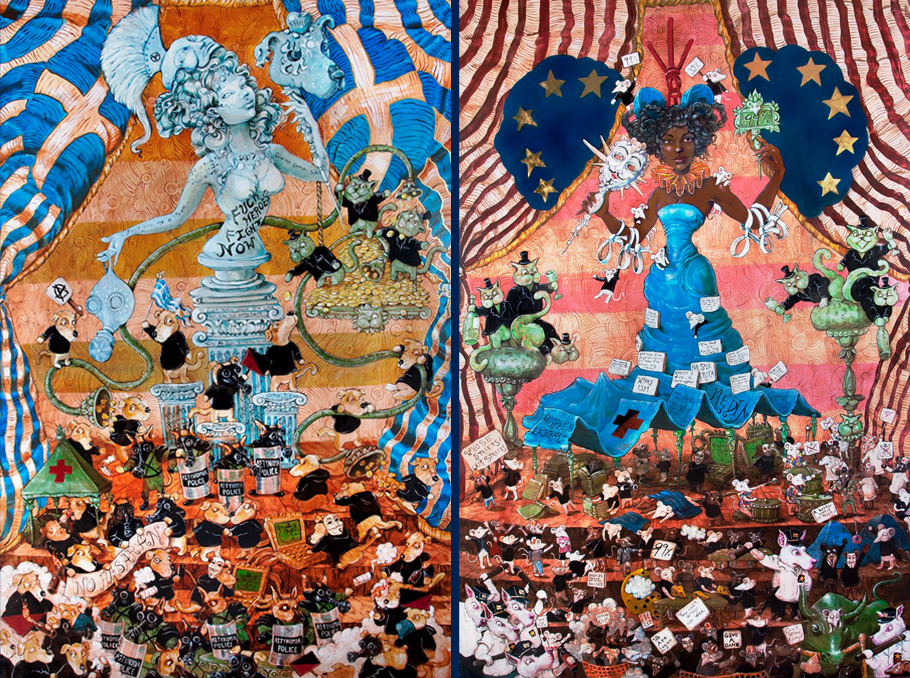 Illustrations by Molly Crabapple from the “Shell Game” exhibition. From right: "Our Lady of Liberty Park", from left: "Syntagma Athena"
Illustrations by Molly Crabapple from the “Shell Game” exhibition. From right: "Our Lady of Liberty Park", from left: "Syntagma Athena"There is a book called “If We Burn: The Mass Protest Decade and the Missing Revolution” by a wonderful writer named Vincent Bevins. It is about why leaderless protests often end up creating the exact opposite of what people wanted. The author emphasizes the need to name the goals and spokespeople. Although I love protests with all my heart, I find Vincent's criticism very appropriate.
- All of this applies to us as well. In Armenia in 2018, people took to the streets to reject the corrupt authorities. They aimed for a new and better Armenia, but after the revolution, we lost the war, we lost Artsakh and now the authorities that came to power due to that revolution continue to cede new territories. And if before we were fighting purely against social injustice, now we are fighting for existential issues.
Having been to various hot spots around the world, witnessing and participating in many protests, what do you think is lacking among people who rise up against injustice, causing such movements to end up in much worse situations?
- I can only speak about the example of the USA. Fifty years ago, the United States was a country with strong labor unions and robust social organizations. It does not matter what kind of organizations they were; what matters is that people had strong connections with each other. Over the past fifty years, those bonds have eroded, especially within labor unions, which have been deliberately crushed by rich individuals connected to politicians. I believe that it is the working class that can change the world.

Photo: Mediamax
On the other hand, people in America did not want to make demands. They believed that even if everything was very bad, unity alone was enough to create a better world together. However, when you do not define your demands, there will be more organized rogues who will make demands on your behalf and hijack your movement. The more organized people are and the clearer their goals, the less risk there is.
- I completely agree. A clear vision is essential not only for addressing immediate demands but also for envisioning the future. In 2018, this was lacking in Armenia; the demand was solely for the resignation of the authorities, without considering the possibility of a worse government coming into power.
- A similar thing happened in Puerto Rico. There, on one hand, the American government exerts pressure; on the other hand, the local authorities are highly corrupt. They just steal and steal and steal. Moreover, they are extremely stupid and they hate Puerto Rico.
In 2017, as a result of the devastating hurricane “Maria”, the electricity and water supply infrastructures were completely disrupted, creating a terrible situation. But neither the local authorities nor the federal authorities did anything.
One of my friends’ neighborhood had no electricity for 8 months. Old and sick people had to walk the mountain to get water, and there were many deaths. Years later, the corrupt governor was caught in a group chat where he was making fun of all the people who died. It was simply disgusting, and hundreds of thousands of people took to the streets to demand his resignation. He left because every third person on the island demanded it, but there were no other demands defined, and after those events he was replaced by an even more corrupt leader who began selling off the islands. For example, he passed a law requiring people born in Puerto Rico to pay more taxes than foreigners. That way they want to drive the local population out and turn the country into just a vacation zone where the locals will be at best servants offering Piña Colada.

And this is another example that you cannot get away from real politics. I felt something akin to romantic love for the protests. But ultimately, as we all know, romantic love does not sustain itself forever.
- I would also like to discuss your journalistic work. It seems you have pioneered a new documentary genre: portraying reality through sketches. Journalists often encounter filming restrictions, but you break through them using your drawing talent. I was particularly impressed by your sketches in 2018 illustrating the harsh treatment of migrants entering the US from the Mexican border. I have also learned, that following your initial sketches, a new restriction was added alongside the ban on courtroom filming – “No sketching”.
- Yeah, and that is funny, because who could have ever thought to ban sketching? Those trials were disgusting. Picture 12-year-old children who are separated from their mothers and brought to court after enduring hell while crossing the border.
 “A Mass Trial of Immigrants”, by Molly Crabapple for Rolling Stone
“A Mass Trial of Immigrants”, by Molly Crabapple for Rolling StoneThey have to answer the judge's questions and represent themselves, often not knowing Spanish but speaking indigenous languages, with translators in courtroom unfamiliar with those languages. The government treats them like criminals when all they seek is safety and being away from local gangs. These staged trials are a disgrace, which is why the government opposes visual representations of them.
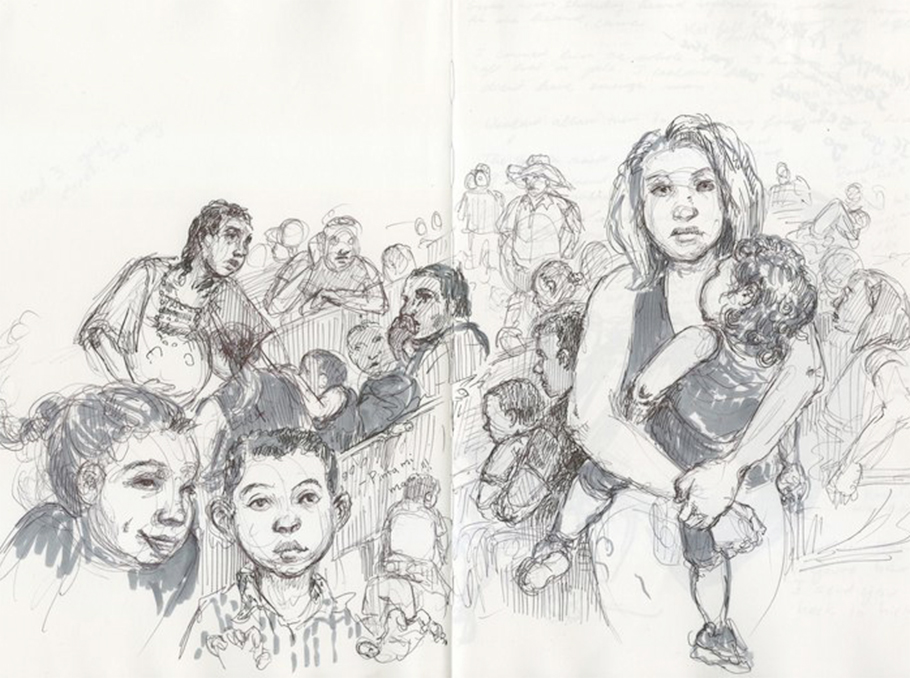 “Families at The Border”, by Molly Crabapple for Rolling Stone
“Families at The Border”, by Molly Crabapple for Rolling StoneApart from the ban on filming, the advantage of sketching as a documentary tool is that people in vulnerable situations are more likely to allow you to draw them, rather than to be photographed.
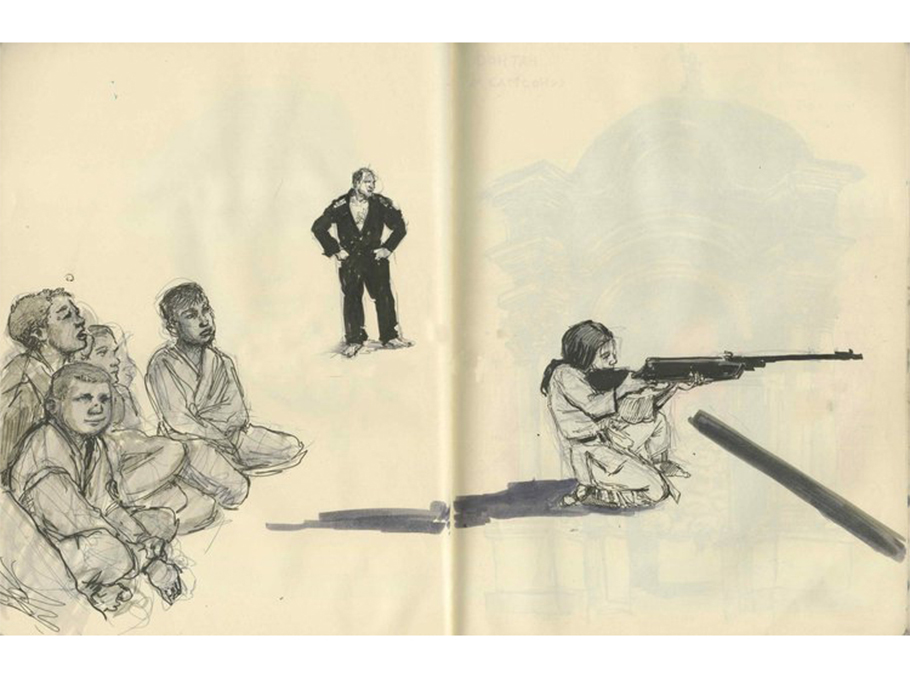 Children learn how to shoot, Bucha, Ukraine By Molly Crabapple for New York Review of Books
Children learn how to shoot, Bucha, Ukraine By Molly Crabapple for New York Review of BooksIt feels like a collaborative effort, takes time, and if someone does not want to be drawn, they can simply walk away. It is completely different from having a camera put in their faces.
- Thank you very much for the interesting conversation, and I have one last question: What is worth fighting for, and what are you personally fighting for?
- This is always a personal question, right? But in a certain sense, I feel like it is also the same for a lot of people, as we all want to live in our homes with dignity, have enough time to be with our family and friends, and not work all the time as slaves. We want to have the freedom to speak, we want for kids to grow up healthy, have a freedom and safety.

Photo: Mediamax
I am from New York. My mother’s family has lived in New York for one hundred and twenty years. It is my city, and I love it in my bones. What is happening now, not just in New York but in cities around the world, is that very rich people are making cities unlivable for anyone who is not extremely rich. They are making it impossible to have communities in cities. They are making it impossible to get by if you are just a working-class person, like a teacher or a garbage man. They are turning cities into consumable objects where normal people are their servants. I guess I am fighting for the New York where everyone can live freely, flourish, and thrive. There are obviously graver issues in the world, like the right to live and freedom, and I am constantly on the streets for Gaza. But for myself, my fight is for the right to have a working-class life in the city I was born in and not let it become a plaything for foreign billionaires.
Gaiane Yenokian talked to Molly Crabapple














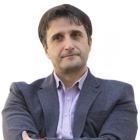










Comments
Dear visitors, You can place your opinion on the material using your Facebook account. Please, be polite and follow our simple rules: you are not allowed to make off - topic comments, place advertisements, use abusive and filthy language. The editorial staff reserves the right to moderate and delete comments in case of breach of the rules.